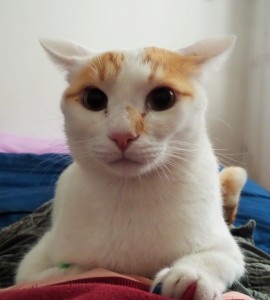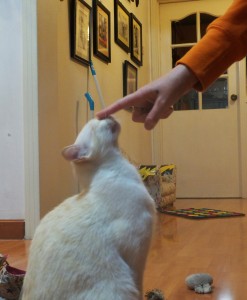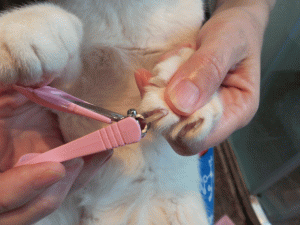
Before you actually acquire your cat, think long and hard about the commitment that awaits you. The rewards offered by having a full-time companion are immeasurable, but so is the commitment required. Most cats live up to sixteen years and require daily care and attention. Also, they can cost a lot of money, especially when it comes to medical bills and moving expenses. If you are ready to make this commitment you will be fulfilled and appreciated by your new found fuzzy little cutie-pie fluff face. However, if you are unsure or not ready yet, there are a lot of smaller pets that you can own that require less care and commitment. For example, a hamster, mouse, or goldfish all make wonderful pets and may be the first step needed to learn about the responsibilities involved with pet ownership.
Advertisement: Click here to play Spot the Kitty
Step 1 – Acquiring your cat…
You’re all excited; today is the day you’ve been waiting for all this time. Today is the day you finally become a fully-fledged cat owner. Put your big boy/girl pants on and hold on to your hat because you are in for one heck of a ride.
When it comes to selecting the right cat breed there are a few things to consider: for instance, allergies and cat hair length. Generally speaking, the shorter the hair that the cat has, the less irritating it is to be around for allergy sufferers. Some cat breeds are found to be less allergenic than others. For instance, Siamese cats often cause little to no irritation to allergy sufferers.
Longer haired cats need to be brushed fairly often or they get painful clumps of hair that annoy them and make them grumpy when you try to hold them. They can also be quite uncomfortable in hot climates. Some breeds are more prone to certain cat diseases. For example, Persians tend to have more respiratory problems; in fact, some airlines will not carry them for this reason.
As well as the above considerations, make sure you pick a cat with the kind of temperament you can enjoy every day. If you enjoy cuddling, choose a kitty that you can pick up and hold for a prolonged period of time without it trying to squirm away or bite you. If you’re looking for a playmate, pick the most active kitty in the litter. If you have other animals in the house, you should pick a cat who is already used to being around other animal friends. Also, make sure that your cat is aesthetically pleasing to YOU: whether it has one eye, three legs and a stunted tail or if it has bad breath doesn’t matter as long as you like it, because ultimately it is your cat and you are the one who is going to be living with the little cutesy-wootsie-pie.
Now, you can go to a pet store and buy a fancy cat there, and that is all well and good, but please don’t overlook all the sad and lonely stray or abandoned cats left in shelters and SPCA-sponsored facilities in your area. You may also look for a friend whose cat has a litter of kittens, or check your local pet classifieds for people with kittens to give away. No matter where you choose your kitty, make sure that he/she is at least eight weeks old before you take it away from its mommy, because kittens need to be with their mommies until they are properly weaned in order to grow into strong, healthy, happy cats, and mommy cats teach their little ones a lot of important cat knowledge that they can’t learn anywhere else.
Step 2 – Getting the right supplies…
Before you bring your new kitty cat home, you are going to have to get some basic supplies. The most important things are a safety (quick release) collar for an ID tag/rabies tag, in case your kitty ever gets out of your home, kitty-friendly food and water bowls, and a litter box with kitty litter. It is ideal to get these items before you get your cat and have everything ready and waiting.
Make sure that there is some wiggle room when you put on the collar: you should be able to stick one or two fingers underneath. If you have a kitten, pay attention to the collar and loosen it as the kitty grows.
For food, talk to your vet about what you need to feed your cat. Keep in mind that cats are carnivores; though they do like to munch on a little grass or house plants from time to time, the majority of their food should be meat-based. If you can afford the more expensive cat food from the vet, great; if not then you can always opt for the supermarket brand. If you bring home a kitten, make sure you buy food that is produced specifically for kittens.
As far as the litter goes, there are a wide-range of kitty litters out there designed for different things. Get the litter that you think is best suited for your kitty, your home, and your budgetary needs. If you have a big house, you might need two litter boxes, and multi-cat households should have at least one box per cat.
When you first bring Fluffy home, put him/her down and walk him/her to the litter box. If he is still a kitten, show him how to use the litter by dragging his little paw through it a few times. If she is already a grown-up kitty, she will already be an expert in the area of kitty litter.
Sometimes when kitties don’t use their litter box to go potty, they are not trying to be mean or act up but perhaps do not like their litter substrate; if your kitty pees on your furniture instead of in the litter box, try changing types of litter. The problem could also be the box style. If it’s too enclosed, your cat might not like it; it gets quite stinky inside, and besides, cats like an open space for going potty where they can keep an eye on their surroundings. Click here for more details on litter…
When it comes to water, nothing beats tap water if your tap water is drinkable. If it is not drinkable, then use filtered or bottled water for your kitty. Make sure that your kitty always has a clean bowl full of fresh water, or else she can get a urinary tract infection and other health problems may develop. Never put their food and water dish by their kitty litter, because cats hate when you do that! In the wild, they would never eat food close to where they use the bathroom and it is against their natural instincts to do so.
Oh I almost forgot… Kitty treats! Never forget kitty treats! Kitties love kitty treats and will form a tight bond with you and whoever else gives them kitty treats.
Step 3 – The first few days of cat ownership…
First things first: take your new kitty to the vet for a checkup and get the new kitty entered into the system so that you have a place to take it if any problems arise. Your vet will inform you of the correct schedule for your cat’s vaccinations and if there are any unnoticed problems that need to be addressed.
After the vet visit, take your kitty home and let him explore his new environment and get used to the new surroundings. Letting it explore and smell everything is vital for allowing the cat to settle in. If you live in a very big house, you might want to limit your new kitty to a small area at first until he feels comfortable.
Show the kitty its litter box and make sure it is filled with litter. Any time you move the litter box to a different location, make sure you show the kitty the litter box by walking the kitty to the litter box and by putting the kitty inside the litter box so it knows that is where it is to go to the bathroom. Litter-box relocations should be done gradually, a few feet a day, or your kitty might get confused.
Give your kitty lots of food and water and show your kitty where its food and water are. Make sure that it has fresh water every day from now on and fresh, clean food. Check that leftover food doesn’t have gunky bits in it, because kitties like to spill their water dish into their food bowl. Some cat owners prefer to give their kitty unlimited access to dry food; however, some dry foods give you a daily feeding amount based on the size of your kitty. If your kitty seems to be getting fat, it would be a good idea to limit food to the amount recommended by the cat-food manufacturer. A kitty with a flap of tummy hanging down underneath when it stands up is considered to be overweight by vets.
Make sure you play with your kitty and give your kitty a little treat when she cuddles with you; this will train her to be as cuddly as possible and will help you to develop a friendship with the cat. If your cat wants to leave your embrace, let her leave, as the world is an exciting and new place to explore. Keep your cat indoors and do not let it outside until you know that it is safe — fully vaccinated and a safe outside environment to play in.
Kitty-proof your house: Make sure that your house is pet safe and there aren’t any exposed electrical outlets or wires that the cat can hurt themselves with. Also, make sure that all gift-wrap ribbon is securely put away, as cats love to eat this stuff, but it’s very harmful for them; if your cat does eat ribbon or string, take him to the vet.
Kitties love sleeping with their human. Put a soft blanket on your bed and have the kitty sleep there with you and try not to roll over and crush your kitty during the night.
Step 4 – Doctor, doctor give me the news, I’ve got a bad case of loving you!…
From here on in, it’s safe to say that you have a fairly good grasp of how to properly look after your new addition to the family. Now here comes the fun part: vet visits. I know that there is a lot of controversy out there regarding vaccinations and whether or not people are vaccinating their children and I do not want to get into that, but it is safe to say that vaccinations for kitty cats do not cause autism or any other developmental issues for the cat throughout the cat’s lifetime. So, regardless of your personal feelings towards vaccinations for your children, please do your kitty a solid and take them to your vet to get them vaccinated and dewormed as soon as they reach six weeks of age. You will have to take your cat back intermittently throughout its lifetime for booster shots. If you follow all the advice for keeping your kitty healthy and safe, you should have a pretty easy time of things regarding health and vet visits. However, if you do think your kitty is ill, for example, sneezing/runny nose, lethargic, not eating, or not pooping/peeing normally, then take him to the vet immediately. Cat diseases or problems can be lethal!
Step 5 – Enjoying the little fuzz fuzz head…
Now that you have done all of the above steps it is time to sit back, relax, and let the good times begin. Make sure you take lots of photos of your kitty doing silly things and share them on Spot the Kitty’s Facebook, Instagram, Twitter, etc… There are also a lot of fun community events that you can partake in now that you are a cat owner, but most importantly, don’t forget about Caturday, the day when you post your favourite photos of your cat to the internet.
Well, I have to hand it to you, choosing to own a kitty cat and have a living breathing cuddly sentient being as part of your life that you will enjoy and treat nicely means a lot to all of the people at Spot the Kitty HQ. We will be updating this guide periodically as new information and time becomes available. Thank you for reading and as always, if you have any questions or feedback for us, please contact us using our feedback form.
– By K.I Borrowman











